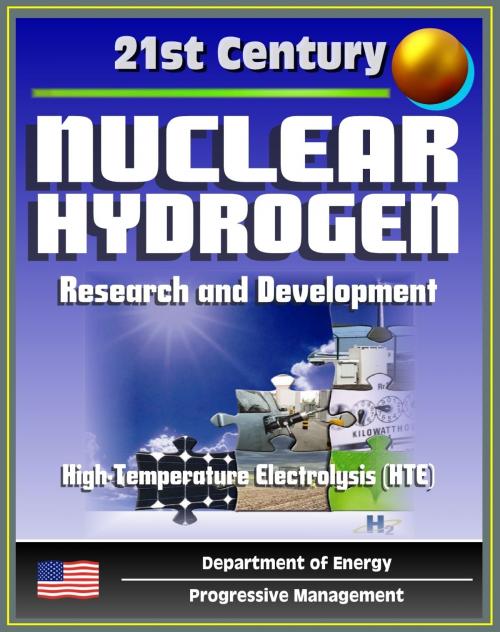21st Century Nuclear Hydrogen Research and Development, Production of Hydrogen from Nuclear Energy for the Hydrogen Initiative, Feedstocks, High-Temperature Electrolysis (HTE), Fuel Cycle
Nonfiction, Science & Nature, Science, Biological Sciences, Ecology, Social & Cultural Studies, Political Science, Government, Public Policy| Author: | Progressive Management | ISBN: | 9781458037909 |
| Publisher: | Progressive Management | Publication: | February 23, 2011 |
| Imprint: | Smashwords Edition | Language: | English |
| Author: | Progressive Management |
| ISBN: | 9781458037909 |
| Publisher: | Progressive Management |
| Publication: | February 23, 2011 |
| Imprint: | Smashwords Edition |
| Language: | English |
The Nuclear Hydrogen Research and Development Plan from the U.S. Department of Energy, Office of Nuclear Energy, describes ongoing plans for demonstrating the production of clean hydrogen fuel from nuclear energy. Hydrogen is abundant in nature but occurs primarily in stable compounds that require significant energy to produce hydrogen for use as a fuel. Hydrogen is an energy carrier, much like electricity, that requires a primary energy source to produce. Domestic energy sources that do not generate greenhouse gases and have the potential to produce hydrogen at costs competitive with gasoline will be essential components of the long-term energy supply. The DOE Hydrogen Program is investigating the potential for all of the practical energy sources for hydrogen production, including: Fossil sources with carbon sequestration (coal and natural gas), Renewable energy sources (solar, wind, and hydroelectric), Biological methods (biomass and biological), Nuclear energy. In the long term, economics and national policy will determine the mix of energy sources that are implemented, and the technologies initially implemented may differ from those ultimately selected for long-term deployment. In any scenario, domestically based, emission-free energy sources will be high priority candidates for further development. Among these primary energy sources, nuclear energy offers great potential for the large-scale production of hydrogen that is virtually emission-free and generated from domestic resources. The production of hydrogen represents a new mission for nuclear energy that is potentially larger than the current mission of emission-free electrical production. To accomplish this goal: Efficient, large-scale production methods suitable for use with advanced nuclear reactors must be demonstrated. The most promising production methods are in the early stages of development. The NHI will develop and demonstrate these hydrogen production methods. Very high temperatures or high-efficiency electricity is required to drive the most promising hydrogen production processes. Advanced nuclear systems must be developed that provide the necessary high heat to enable these processes. The DOE Generation IV Nuclear Systems Initiative (Generation IV) is developing options to address this need with international collaboration. The focus of this effort is the Very High Temperature Reactor (VHTR), which would provide the advanced nuclear heat source for demonstrating nuclear hydrogen and electricity production. The DOE Office of Nuclear Energy, Science, and Technology (NE) is considering a major demonstration project, which would demonstrate the commercial potential of hydrogen production from nuclear energy at a 50 megawatt thermal (MWth) scale by 2017 and provide a basis for industry investment decisions. The Next Generation Nuclear Plant (NGNP) project would develop and demonstrate the VHTR with the most promising hydrogen production processes developed by the Nuclear Hydrogen Initiative. For hydrogen production from nuclear energy to be sustainable, the technology and policy questions that have limited nuclear energy s contribution to the energy supply must also be addressed. Advanced reactor systems that are passively safe, more efficient, and demonstrably cost effective are essential to the wider public acceptance of the nuclear role. The advantage of more efficient fuel cycles that minimize waste volumes, toxicity, and proliferation concerns must be considered.
The Nuclear Hydrogen Research and Development Plan from the U.S. Department of Energy, Office of Nuclear Energy, describes ongoing plans for demonstrating the production of clean hydrogen fuel from nuclear energy. Hydrogen is abundant in nature but occurs primarily in stable compounds that require significant energy to produce hydrogen for use as a fuel. Hydrogen is an energy carrier, much like electricity, that requires a primary energy source to produce. Domestic energy sources that do not generate greenhouse gases and have the potential to produce hydrogen at costs competitive with gasoline will be essential components of the long-term energy supply. The DOE Hydrogen Program is investigating the potential for all of the practical energy sources for hydrogen production, including: Fossil sources with carbon sequestration (coal and natural gas), Renewable energy sources (solar, wind, and hydroelectric), Biological methods (biomass and biological), Nuclear energy. In the long term, economics and national policy will determine the mix of energy sources that are implemented, and the technologies initially implemented may differ from those ultimately selected for long-term deployment. In any scenario, domestically based, emission-free energy sources will be high priority candidates for further development. Among these primary energy sources, nuclear energy offers great potential for the large-scale production of hydrogen that is virtually emission-free and generated from domestic resources. The production of hydrogen represents a new mission for nuclear energy that is potentially larger than the current mission of emission-free electrical production. To accomplish this goal: Efficient, large-scale production methods suitable for use with advanced nuclear reactors must be demonstrated. The most promising production methods are in the early stages of development. The NHI will develop and demonstrate these hydrogen production methods. Very high temperatures or high-efficiency electricity is required to drive the most promising hydrogen production processes. Advanced nuclear systems must be developed that provide the necessary high heat to enable these processes. The DOE Generation IV Nuclear Systems Initiative (Generation IV) is developing options to address this need with international collaboration. The focus of this effort is the Very High Temperature Reactor (VHTR), which would provide the advanced nuclear heat source for demonstrating nuclear hydrogen and electricity production. The DOE Office of Nuclear Energy, Science, and Technology (NE) is considering a major demonstration project, which would demonstrate the commercial potential of hydrogen production from nuclear energy at a 50 megawatt thermal (MWth) scale by 2017 and provide a basis for industry investment decisions. The Next Generation Nuclear Plant (NGNP) project would develop and demonstrate the VHTR with the most promising hydrogen production processes developed by the Nuclear Hydrogen Initiative. For hydrogen production from nuclear energy to be sustainable, the technology and policy questions that have limited nuclear energy s contribution to the energy supply must also be addressed. Advanced reactor systems that are passively safe, more efficient, and demonstrably cost effective are essential to the wider public acceptance of the nuclear role. The advantage of more efficient fuel cycles that minimize waste volumes, toxicity, and proliferation concerns must be considered.















